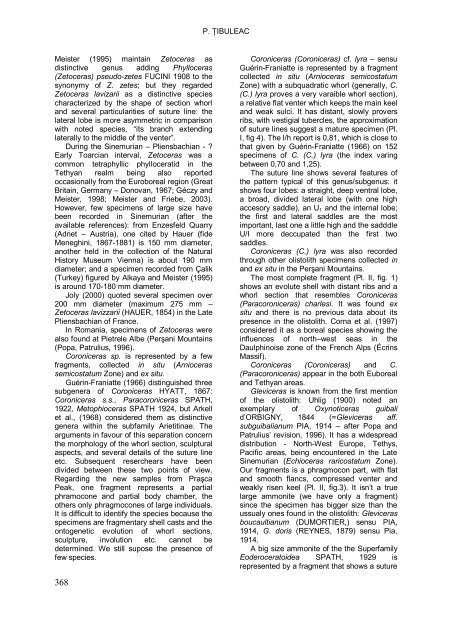presence of big size ammonites in the jurassic olistoliths
presence of big size ammonites in the jurassic olistoliths
presence of big size ammonites in the jurassic olistoliths
You also want an ePaper? Increase the reach of your titles
YUMPU automatically turns print PDFs into web optimized ePapers that Google loves.
P. ŢIBULEAC<br />
Meister (1995) ma<strong>in</strong>ta<strong>in</strong> Zetoceras as<br />
dist<strong>in</strong>ctive genus add<strong>in</strong>g Phylloceras<br />
(Zetoceras) pseudo-zetes FUCINI 1908 to <strong>the</strong><br />
synonymy <strong>of</strong> Z. zetes; but <strong>the</strong>y regarded<br />
Zetoceras lavizarii as a dist<strong>in</strong>ctive species<br />
characterized by <strong>the</strong> shape <strong>of</strong> section whorl<br />
and several particularities <strong>of</strong> suture l<strong>in</strong>e: <strong>the</strong><br />
lateral lobe is more asymmetric <strong>in</strong> comparison<br />
with noted species, “its branch extend<strong>in</strong>g<br />
laterally to <strong>the</strong> middle <strong>of</strong> <strong>the</strong> venter”.<br />
Dur<strong>in</strong>g <strong>the</strong> S<strong>in</strong>emurian – Pliensbachian - ?<br />
Early Toarcian <strong>in</strong>terval, Zetoceras was a<br />
common tetraphyllic phylloceratid <strong>in</strong> <strong>the</strong><br />
Tethyan realm be<strong>in</strong>g also reported<br />
occasionally from <strong>the</strong> Euroboreal region (Great<br />
Brita<strong>in</strong>, Germany – Donovan, 1967; Géczy and<br />
Meister, 1998; Meister and Friebe, 2003).<br />
However, few specimens <strong>of</strong> large <strong>size</strong> have<br />
been recorded <strong>in</strong> S<strong>in</strong>emurian (after <strong>the</strong><br />
available references): from Enzesfeld Quarry<br />
(Adnet – Austria), one cited by Hauer (fide<br />
Menegh<strong>in</strong>i, 1867-1881) is 150 mm diameter,<br />
ano<strong>the</strong>r held <strong>in</strong> <strong>the</strong> collection <strong>of</strong> <strong>the</strong> Natural<br />
History Museum Vienna) is about 190 mm<br />
diameter; and a specimen recorded from Çalik<br />
(Turkey) figured by Alkaya and Meister (1995)<br />
is around 170-180 mm diameter.<br />
Joly (2000) quoted several specimen over<br />
200 mm diameter (maximum 275 mm –<br />
Zetoceras lavizzarii (HAUER, 1854) <strong>in</strong> <strong>the</strong> Late<br />
Pliensbachian <strong>of</strong> France.<br />
In Romania, specimens <strong>of</strong> Zetoceras were<br />
also found at Pietrele Albe (Perşani Mounta<strong>in</strong>s<br />
(Popa, Patrulius, 1996).<br />
Coroniceras sp. is represented by a few<br />
fragments, collected <strong>in</strong> situ (Arnioceras<br />
semicostatum Zone) and ex situ.<br />
Guér<strong>in</strong>-Franiatte (1966) dist<strong>in</strong>guished three<br />
subgenera <strong>of</strong> Coroniceras HYATT, 1867:<br />
Coroniceras s.s., Paracoroniceras SPATH,<br />
1922, Metophioceras SPATH 1924, but Arkell<br />
et al., (1968) considered <strong>the</strong>m as dist<strong>in</strong>ctive<br />
genera with<strong>in</strong> <strong>the</strong> subfamily Arietit<strong>in</strong>ae. The<br />
arguments <strong>in</strong> favour <strong>of</strong> this separation concern<br />
<strong>the</strong> morphology <strong>of</strong> <strong>the</strong> whorl section, sculptural<br />
aspects, and several details <strong>of</strong> <strong>the</strong> suture l<strong>in</strong>e<br />
etc. Subsequent reserchears have been<br />
divided between <strong>the</strong>se two po<strong>in</strong>ts <strong>of</strong> view.<br />
Regard<strong>in</strong>g <strong>the</strong> new samples from Praşca<br />
Peak, one fragment represents a partial<br />
phramocone and partial body chamber, <strong>the</strong><br />
o<strong>the</strong>rs only phragmocones <strong>of</strong> large <strong>in</strong>dividuals.<br />
It is difficult to identify <strong>the</strong> species because <strong>the</strong><br />
specimens are fragmentary shell casts and <strong>the</strong><br />
ontogenetic evolution <strong>of</strong> whorl sections,<br />
sculpture, <strong>in</strong>volution etc. cannot be<br />
determ<strong>in</strong>ed. We still supose <strong>the</strong> <strong>presence</strong> <strong>of</strong><br />
few species.<br />
368<br />
Coroniceras (Coroniceras) cf. lyra – sensu<br />
Guér<strong>in</strong>-Franiatte is represented by a fragment<br />
collected <strong>in</strong> situ (Arnioceras semicostatum<br />
Zone) with a subquadratic whorl (generally, C.<br />
(C.) lyra proves a very varaible whorl section),<br />
a relative flat venter which keeps <strong>the</strong> ma<strong>in</strong> keel<br />
and weak sulci. It has distant, slowly provers<br />
ribs, with vestigial tubercles, <strong>the</strong> approximation<br />
<strong>of</strong> suture l<strong>in</strong>es suggest a mature specimen (Pl.<br />
I, fig 4). The l/h report is 0,81, which is close to<br />
that given by Guér<strong>in</strong>-Franiatte (1966) on 152<br />
specimens <strong>of</strong> C. (C.) lyra (<strong>the</strong> <strong>in</strong>dex var<strong>in</strong>g<br />
between 0,70 and 1,25).<br />
The suture l<strong>in</strong>e shows several features <strong>of</strong><br />
<strong>the</strong> pattern typical <strong>of</strong> this genus/subgenus: it<br />
shows four lobes: a straight, deep ventral lobe,<br />
a broad, divided lateral lobe (with one high<br />
accesory saddle), an U 1 and <strong>the</strong> <strong>in</strong>ternal lobe;<br />
<strong>the</strong> first and lateral saddles are <strong>the</strong> most<br />
important, last one a little high and <strong>the</strong> sadddle<br />
U/I more deccupated than <strong>the</strong> first two<br />
saddles.<br />
Coroniceras (C.) lyra was also recorded<br />
through o<strong>the</strong>r olistolith specimens collected <strong>in</strong><br />
and ex situ <strong>in</strong> <strong>the</strong> Perşani Mounta<strong>in</strong>s.<br />
The most complete fragment (Pl. II, fig. 1)<br />
shows an evolute shell with distant ribs and a<br />
whorl section that resembles Coroniceras<br />
(Paracoroniceras) charlesi. It was found ex<br />
situ and <strong>the</strong>re is no previous data about its<br />
<strong>presence</strong> <strong>in</strong> <strong>the</strong> olistolith. Corna et al. (1997)<br />
considered it as a boreal species show<strong>in</strong>g <strong>the</strong><br />
<strong>in</strong>fluences <strong>of</strong> north–west seas <strong>in</strong> <strong>the</strong><br />
Daulph<strong>in</strong>oise zone <strong>of</strong> <strong>the</strong> French Alps (Écr<strong>in</strong>s<br />
Massif).<br />
Coroniceras (Coroniceras) and C.<br />
(Paracoroniceras) appear <strong>in</strong> <strong>the</strong> both Euboreal<br />
and Tethyan areas.<br />
Gleviceras is known from <strong>the</strong> first mention<br />
<strong>of</strong> <strong>the</strong> olistolith: Uhlig (1900) noted an<br />
exemplary <strong>of</strong> Oxynoticeras guibali<br />
d’ORBIGNY, 1844 (=Gleviceras aff.<br />
subguibalianum PIA, 1914 – after Popa and<br />
Patrulius’ revision, 1996). It has a widespread<br />
distribution - North-West Europe, Tethys,<br />
Pacific areas, be<strong>in</strong>g encountered <strong>in</strong> <strong>the</strong> Late<br />
S<strong>in</strong>emurian (Echioceras raricostatum Zone).<br />
Our fragments is a phragmocon part, with flat<br />
and smooth flancs, compressed venter and<br />
weakly risen keel (Pl. II, fig.3). It isn’t a true<br />
large ammonite (we have only a fragment)<br />
s<strong>in</strong>ce <strong>the</strong> specimen has <strong>big</strong>ger <strong>size</strong> than <strong>the</strong><br />
ussualy ones found <strong>in</strong> <strong>the</strong> olistolith: Gleviceras<br />
boucaultianum (DUMORTIER,) sensu PIA,<br />
1914, G. doris (REYNES, 1879) sensu Pia,<br />
1914.<br />
A <strong>big</strong> <strong>size</strong> ammonite <strong>of</strong> <strong>the</strong> <strong>the</strong> Superfamily<br />
Eoderoceratoidea SPATH, 1929 is<br />
represented by a fragment that shows a suture
















